Brooding Management
- Brooding is art and science of rearing chicks up to the age of three weeks. Newly hatched chicks not fully developed through thermoregulatory mechanism takes about two weeks to develop.
- In order to maintain its body temperature, external heat is provided which is known as brooding. Heating source may be electrical, gases like natural gas, LPG and methane, liquid fuel like kerosene, solid fuel like coal, wood etc. can be used as heating materials. If electricity is not available, ordinary charcoal / kerosene stoves are used to provide supplementary heat to chicks.
- In the deep litter, a hover with one meter diameter, 250 chicks can be brooded. The hover can be metal or bamboo basket fitted with a heat source. The size and number of the hovers depend on the number of chicks to be brooded.
- The hover can be placed at appropriate height from the floor either by hanging it from the roof or by placing it over bricks or stones so that chicks can go in and out easily. Units of 250 chicks are ideal for efficient management.
- Temperature required for brooding is 1 to 2 Watt/chick. Hence, five bulbs of 60 Watts per unit can be used for 250 chicks.
- Electricity is the common source of heat used. Electric bulbs of multiple units are preferred over single bulb to cover the wattage. Infra-red bulbs can also be used for brooding.
- Hover is not necessary when infrared bulbs are used. The number of bulbs to be used depends on the number of chicks to be brooded. The rule of thumb is that one Infra-red bulb of 250 watts can be used for every 250 chicks. Position the bulb 50 cm above litter. The requirement of chicks for additional warmth decreases as they grow. The warmth as measured by thermometer at 5 cm (2 inches) above the floor level should be checked every day.

Brooding can be classified into:
- Natural brooding: It is done with the help of broody hens after hatching, upto 3 to 4 weeks of age.
- Artificial brooding: In artificial brooding, large numbers of baby chicks are reared in the absence of broody hen. Equipments used for brooding are called brooders. Brooder comprises of three elements: 1. Heating source
2. Reflectors
3. Brooder guard Heating source may be electrical; gases like natural gas, LPG and methane, liquid fuel like kerosene, solid fuel like coal, wood can be used as a heating material.
1) Charcoal stove / kerosene stove:
- Used to provide supplementary heat to chicks.
- These stoves are covered with plate / pans to dissipate the heat.
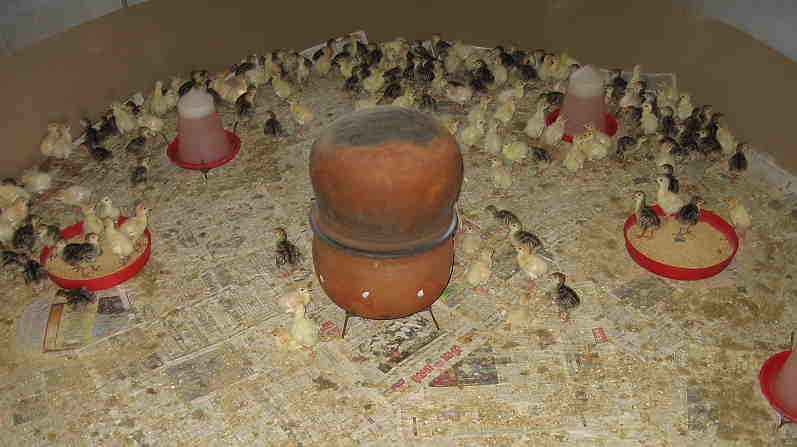
Charcoal stove
2) Gas brooder:
- Natural gas, LPG or methane is connected to heating element which is hanged 3 to 5 feet above the chick to provide heat.
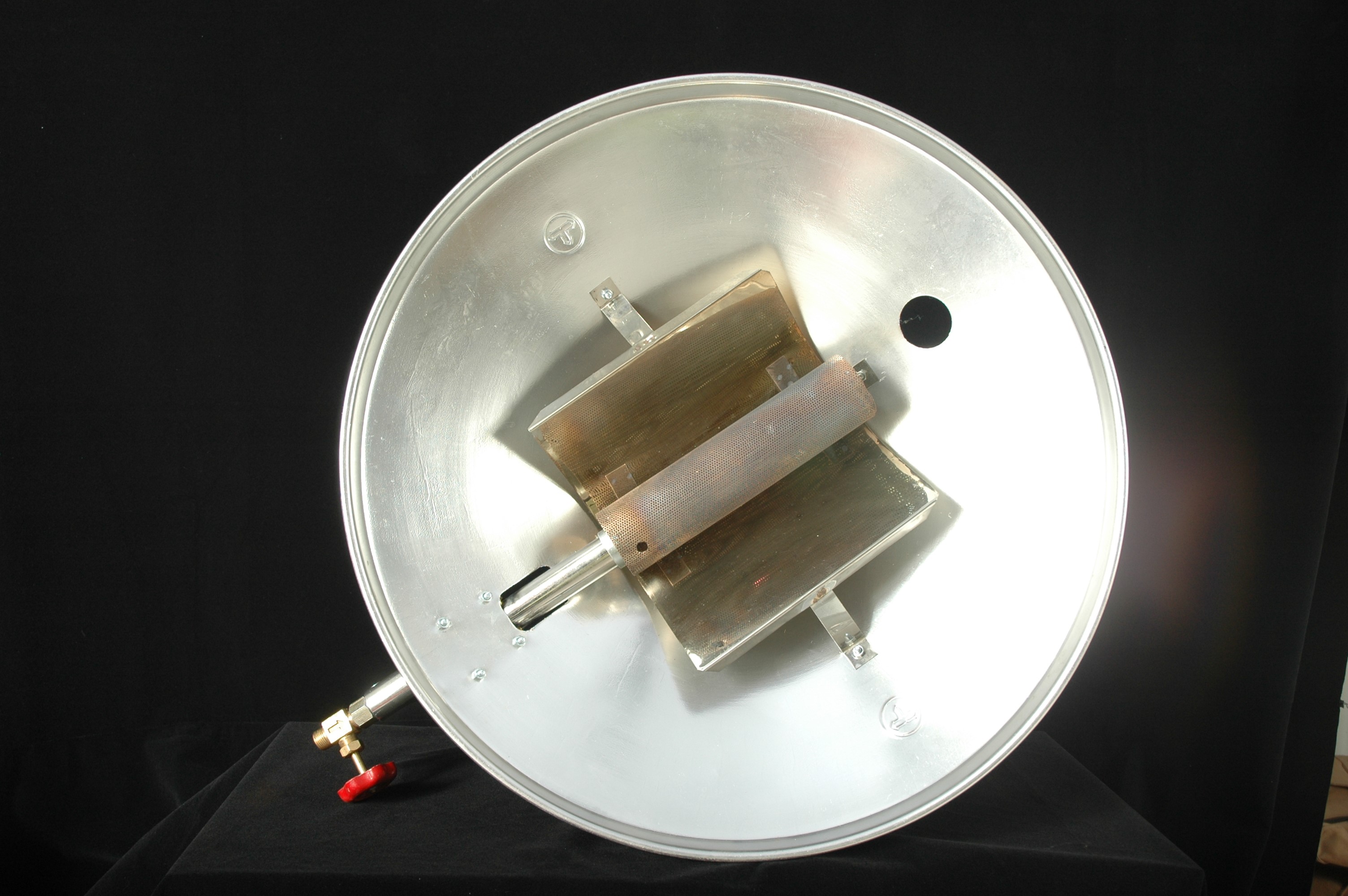
Gas brooder
3) Electrical brooder:
- It is also thermostatically controlled heating system that spread required amount of heat uniformly above large area, to avoid crowding of chicks under brooder directly.
- One electrical brooder can be used for 300 to 400 chicks.
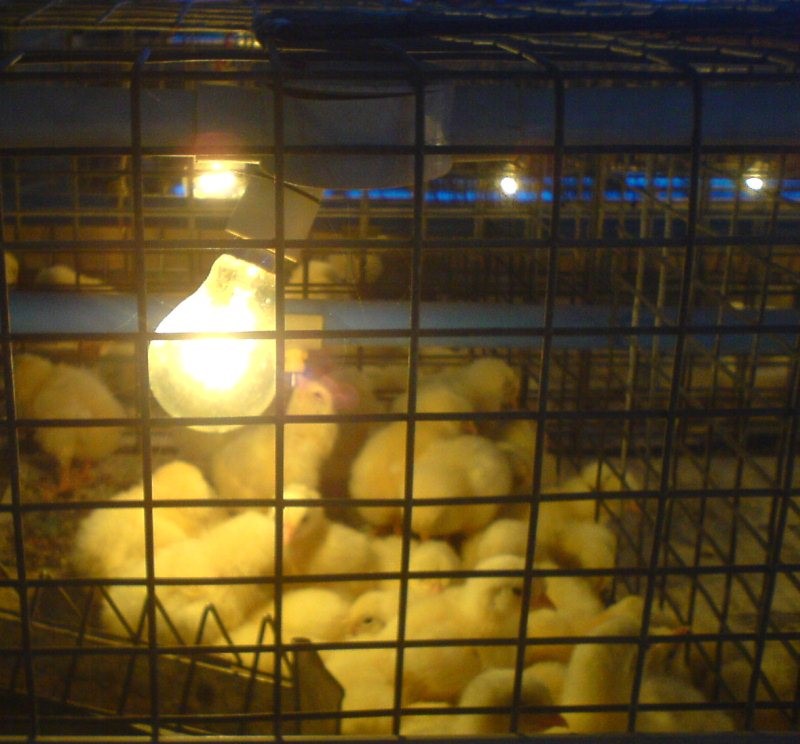
Electrical brooder
4) Infra-red bulbs:
- It is a self reflecting bulb.
- One 250 watts IR bulb can provide brooding for about 150 to 250 chicks.
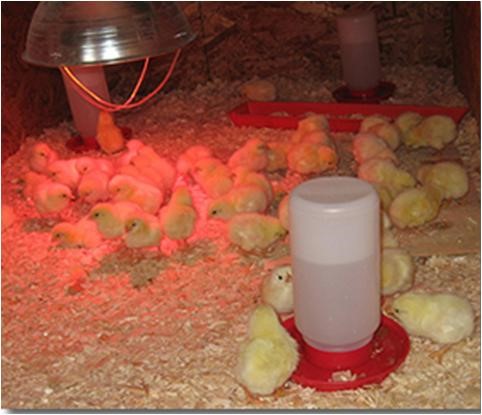
Infra-red bulbs
5) Reflectors:
- These reflectors are called Hovers.
- Flat type hover – These hovers are provided with heating element, heating mechanism and pilot lamp and in some cases thermometer is also included to record the temperature.
- Canopy type hover – These reflectors are in concave shape consisting of ordinary electrical bulb, thermostat mechanism and in some cases thermometer.

Light reflector
6) Brooder guard / chick guard:
- They are used to prevent chicks from straying too far away from heat supply until they learn the source of heat.
- Use materials like cardboard sheet, GI sheet, wire mesh, and mat etc. depending upon the season of brooding.
- During winter season, brooding is done for 5-6 days.
- In summer season, it is 2-3 weeks.

Brooder guard
Brooding temperature:
- Heating is very much essential to provide right temperature in the brooder house. Too high or too low a temperature slows down growth and causes mortality.
- During the first week, the temperature should be 95°F (35°C) which may be reduced by 5°F per week during each successive week till 70°F. The brooder should be switched on for at least 24 hours before the chicks arrive.
- As a rule of thumb the temperature inside the brooder house should be approximately 20°F (6·7°C) below the brooder temperature. Hanging of a maximum and minimum thermometer in each house is recommended to have a guide to control over the differences in the house temperature.
- The behavior of chicks provides better indication of whether they are getting the desired amount of heat. When the temperature is less than required, the chicks try to get closer to the source of heat and huddle down under the brooder.
- When the temperature is too high, the chicks will get away from the source of heat and may even pant or gasp. When temperature is right, the chicks will be found evenly scattered. In hot weather, brooders are not necessary after the chicks are about 3 weeks old.
- Several devices can be used for providing artificial heat. Hover type electric brooders are by far the most common and practical these days. The temperature in these brooders is thermostatically controlled.
- Many a times the heat in the brooder house is provided by use of electric bulbs of different intensities. Regulation of temperature in such cases is difficult although not impossible. Infra-red lamps are also very good for brooding. The height and number of infra-red lamps can be adjusted as per temperature requirement in the brooder house.
Brooder space:
Brooder space of 7 to 10 sq inch (45-65 cm2) is recommended per chick. Thus a 1·80 m hover can hold 500 chicks. When small pens are used for brooding, dimension of the house must be taken into consideration as overcrowding results in starve-outs, culls and increase in disease problems.
Brooder guard:
To prevent the straying of baby chicks from the source of heat, hover guards are placed 1·05 to 1·50 m from the edge of hover. Hover guard is not necessary after 1 week.
Temperature requirement of chicks during different ages
The distribution of chicks under the hover is a better indication of warmth than the thermometer. If the chicks are active, busy eating and drinking, it indicates that the temperature under the hover is comfortable. Generally, one watt per chick appears satisfactory under our climatic conditions.
| Age in weeks | Temperature under hover, at 5 cm above floor (°C) |
|---|---|
| 0-1 | 35 |
| 0-2 | 32 |
| 2-3 | 29 |
| 3-4 | 26 |
| 5-5 | 23 |
Floor space:
Floor space of 0·05 m2 should be provided per chick to start with, which should be increased by 0·05 m2 after every four weeks until the pullets are about 20 weeks of age. For broilers at least 0·1 m2 of floor space for female chicks and 0·15 m2 for male chicks should be provided till eight weeks of age. Raising broiler pullets and cockerel chicks in the separate pens may be beneficial.
Water space:
Plentiful of clean and fresh water is very much essential. A provision of 50 linear cm of water space per 100 chicks for first two weeks has to be increased to 152-190 linear cm at 6 to 8 weeks. When changing from chick fountain to water trough the fountains are to be left in for several days till the chicks have located the new water source. Height of the waterers should be maintained at 2-5 cm above the back height of the chicks to reduce spoilage. Antibiotics or other stress medications may be added to water if desired. All waterers should be cleaned daily. It may be desirable to hold a few chicks one at a time and teach them to drink.
Litter management:
- Litter materials such as wood shavings; saw dust, paddy husk, peanut shell, paddy chaff, chopped straw and such other materials that absorb moisture well can be used depending upon the cost and availability.
- Spread the litter to a depth of 5 cm on the floor before introducing chicks and build it up to a depth of 15 cm by adding litter material, at the rate of about 2 cm per week. This would require approximately 10 kg of litter material/sq.meter.
- Litter should be raked thoroughly at frequent intervals, say at least twice a week, during the cold and rainy season, once a week during the hot season and the day after deworming. Litter should be kept dry always.
- During the cold and rainy season and on the area of floor where watering utensils are placed, special attention should be paid daily to check the litter condition. If required, top-dress with fresh litter. It is desirable to use dry lime at the rate of 10 kg per 10 m3 and rake the litter.
Light:
Artificial light should be discontinued from the time the chicks no more require additional warmth. Dim light of 40-watt bulb for every 250 chicks can be provided during the night for broiler chicks.

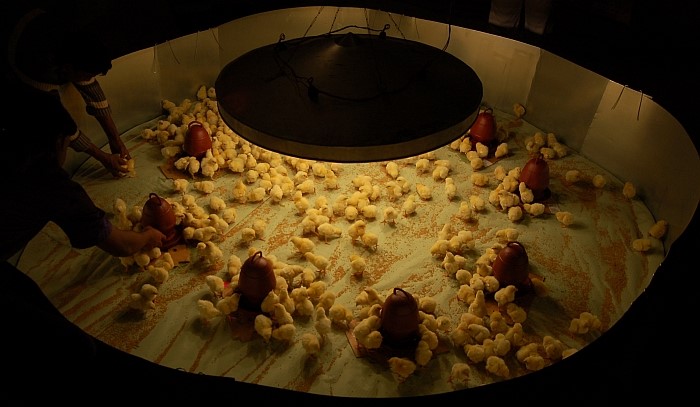
Artificial Brooding

